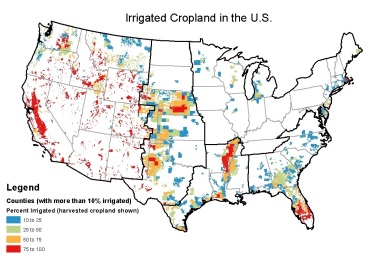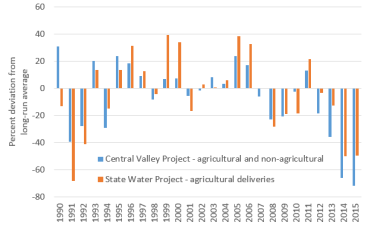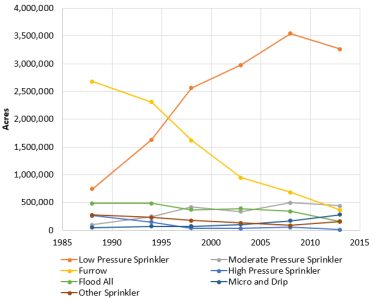
Irrigated agriculture in the United States comes in many forms: Nebraska’s center-pivot-sprinkler-irrigated corn and soybean, California’s drip-irrigated orchards, Arkansas’s flood-irrigated rice, Florida’s furrow-irrigated sugarcane, Massachusetts’ cranberry bogs, and Montana’s movable-sprinkler-irrigated pasture, to name just a few. Such diversity creates challenges for federal agricultural water conservation policy. One of the largest components of that policy—the U.S. Department of Agriculture’s Environmental Quality Incentives Program (EQIP)—has largely addressed this challenge by promoting region-specific irrigation technology. This article examines the outcomes of the EQIP program and other important regional differences and similarities in the foundations of water conservation.
When policy-makers seek to conserve water in the agricultural sector, the purpose is generally to make more water available for other uses, perhaps municipal drinking water or environmental flows, or to increase the water available for irrigation at a future time. Since water law and water allocation decisions are typically determined at a local or state level, the federal role in water conservation has historically been to provide support. The authorizing language for EQIP exemplifies this supporting role by stating that “[t]he purposes of [EQIP]… are to promote agricultural production, forest management, and environmental quality as compatible goals, and to optimize environmental benefits, by assisting producers in complying with local, State, and national regulatory requirements concerning… surface and ground water conservation” (16 U.S. Code Part IV §3839aa).

Source: Calculations based on the 2012 USDA Census
of Agriculture. County boundaries are clipped to show
cropland based on the 2012 National Land Cover Dataset.
Regional boundaries determined by the author.
To capture the broad patterns in incentives for agricultural water conservation, we divide the United States into five regions: the Mountain West, the Central Plains, the Southern Alluvial Aquifers, the Southeastern Coastal Aquifers, and the Midwest/Northeast. These regions were defined to capture broad differences in water supply, crop choice, and irrigation technology. A legacy of early observations by John Wesley Powell and others is the idea that irrigation is necessary for agricultural production west of the 100th meridian and not necessary east of that line (Schlenker, Hanemann, and Fisher, 2005). While there is some truth to this generalization when focusing only on cropland, there are several areas east of the 100th meridian where irrigation is in fact quite common and there are vast areas of dryland production, especially pasture and range, in most areas to the west. County-level variation in the adoption of irrigation—as a share of total harvested cropland—shows these irrigation “hot-spots” (Figure 1). On a basic level, this simply illustrates that the supply of water from rainfall or groundwater is as important as demand for water in determining where irrigation occurs.
A critical driver of regional differences in demand for irrigation is variation in what crops are irrigated (Table 1). In the Mountain West, hay and pasture were the largest share of irrigated acreage in 2013, joined by orchards and a wide variety of other crops that included considerable acreage in vegetables. In the Central Plains, corn, soy, and wheat—often grown together in rotation—dominate and are joined by other crops that included cotton and sorghum. In the Southern Alluvial Aquifers, the same three dominant crops were joined primarily by rice. The Southeastern Coastal Plan spans a wide variety of other crops that included sugar cane, citrus orchards, peanut, and cotton along with some corn, soybeans, and wheat. Lastly, the Midwest and Northeast regions looked somewhat similar to the Central Plains in crop specialization—with their emphasis on corn, soy, and wheat—but the category of other crops tilted more toward vegetables and specialty crops such as cranberries.

Source: Calculations from the 2013 USDA Farm and Ranch Irrigation Survey (U.S. Department
of Agriculture, 2013).
While irrigation can facilitate the production of crops beyond their dryland range, these differences in crop specialization come in part from differences in climate and soils. Few soybeans are grown west of the Central Plains. Almost no cotton is grown north of Texas, Arkansas, and North Carolina. Climate- and soil-driven specialization have a large impact on the technology-based focus of federal water conservation policy as well as on the benefits and costs of water conservation. For example, orchards involve considerable sunk costs in orchard establishment; a large portion of the benefit of applied water, particularly during drought years, involves the preservation of capital embedded in the trees. In contrast, the extensive margin of water demand is more prevalent in many row crops, for which farmers can more easily reduce irrigated acreage. Nonetheless, crops are not located randomly, and many crops that require more water are located in areas with abundant and reliable water supplies.
As noted above, water supply is a major part of the story of irrigation. Irrigation tends to occur where there is sufficient water stored, even in areas with substantial precipitation. Given the fixed costs involved in moving to irrigated production, a critical issue for irrigators is the reliability and extent of their water source. The most basic distinction with respect to the source of water is between surface water and groundwater supplies. Surface water supplies come from capturing runoff in ponds, basins, lakes, or reservoirs. On-farm surface-water storage, typically in small ponds, is an important source of water, but from a policy perspective most surface-water-related water conservation is focused on off-farm storage in large reservoirs, which are often part of state or federal projects. Groundwater supplies come from aquifers, areas of permeable rock, sand, and gravel that contain enough water to support its extraction through wells. Many of the major irrigation areas in the United States are supported by major aquifers containing very large quantities of water, much of which has accumulated over hundreds or thousands of years.
Groundwater is the largest source of water for U.S. irrigated agriculture. Aquifers can be split into unconfined aquifers, in which the movement of water is determined primarily by gravity, and confined aquifers, in which the movement of water is determined primarily by the pressure of the overlying (confining) geologic layers. Irrigation in the High Plains region is predominately based on groundwater stored in the High Plains Aquifer, a system of several overlapping aquifers, the largest of which is the unconfined Ogallala Aquifer. In the Southern Coast Aquifers region, the presence of the unconfined Mississippi Alluvial Aquifer and the (largely) confined Mississippi Embayment allows for extensive irrigation in Arkansas, Mississippi, and—to a lesser extent—Missouri and Louisiana. In the Mountain West, many farms have access to a mix of groundwater and surface water, particularly in areas such as California’s Central Valley. The Central Valley Aquifer, a system of multiple overlaid unconfined and confined aquifers, is a major source of water for much of the irrigation in California. The three aquifer systems account for about 35 million acre-feet of average annual withdrawals (Faunt et al. 2009, Clark et al. 2011, Stanton et al. 2011), representing over 70% of total groundwater used annually for irrigation in the United States.

Source: USGS regional groundwater availability studies (Faunt et al.,
2009; Clark, Hart, and Gurdak, 2011; Stanton et al., 2011).
All three of these aquifer systems, as well as many others, are slowly being depleted as annual withdrawals typically exceed annual recharge. Based on a series of USGS estimates, these three aquifers have been depleted by 8–22% since pumping began (Table 2). While there is still extensive water available in these system, this groundwater overdraft tends to be concentrated in specific subareas of each aquifer (Faunt et al., 2009; Clark, Hart, and Gurdak, 2011; Stanton et al., 2011).
About 46% of all water used for irrigation in the United States comes from surface water supplies (U.S. Department of Agriculture, 2013). Surface water plays a particularly large role in the western United States. Surface-water storage systems interact with the larger hydrological system on a much shorter time scale, capturing runoff from streams and the melting of often distant snowpack, absorbing shallow groundwater discharge, feeding shallow groundwater recharge, and, of course, directly capturing precipitation and contributing to evaporation. While irrigation in general serves as a buffer against the risk of shortfalls in rain, surface water is typically more renewable but less reliable than groundwater. When droughts occur and less water is available in the system, surface water systems inevitably have less water available to distribute to farmers. Some of the largest surface water systems in the western U.S. have the capacity to store water over multiple years, but that capacity is rarely sufficient to provide a complete buffer against drought. During the recent drought in California, the state and federal water projects that deliver surface water to the Central Valley and other areas cut back agricultural deliveries by between 50% and 70% (Figure 2). Many irrigators in the Central Valley were able to temporarily offset a large portion of this shortfall in surface water through increased groundwater pumping (Howitt et al., 2014), but many irrigators impacted by surface water variability do not have access to adequate groundwater.

Source: Author calculations on delivery data proved by the
California Department of Water Resources and the U.S.
Bureau of Reclamation.
Federal water conservation policy as implemented through EQIP largely employs a technological approach. Irrigation technology is the system used to apply water to the crop. Gravity irrigation involves adding water at the end of the furrows between crop rows and allowing the water to flow down between the crops. Pressurized irrigation systems deliver water to crops through sprinklers or drip nozzles. There are many variations on each system, and an important characteristic of any system is its technical efficiency. More efficient irrigation systems reduce the amount of irrigation water lost to evaporation, surface runoff, or deep infiltration, but these systems also often involve greater capital expenses, operating costs, or management effort.
Since water is often not managed through markets or other price-based mechanisms, irrigators may be underinvested in irrigation efficiency. This is one rationale for using government financial assistance programs to encourage the adoption of more efficient irrigation technology. One challenge with this approach is that, given the numerous types of irrigation technologies, improvements in efficiency can take many different forms.
Based on analysis of EQIP contract data, the regional differences described above are reflected in the type of technology that EQIP and similar programs focus on. In the High Plains, the most common irrigation practice supported by EQIP is sprinklers, often low-pressure systems that reduce the amount of applied water lost to evaporation. In contrast, micro and drip irrigation are the most common practices in the Mountain West. In the Gulf Coast Alluvial Aquifers, the most common practice is land leveling, which reduces water loss to runoff. So even though the program involves water conservation at the national level, local initiatives are able to tailor to regional needs. Much of the acreage that receives financial assistance for irrigation technology improvements through EQIP also receives assistance for the adoption of improved water management practices such as better irrigation scheduling.

Source: USDA Farm and Ranch Irrigation Survey,
multiple years.
Large changes in irrigation technology adoption have occurred over the past 20 to 30 years. These changes vary by region and reflect similar shifts as the technology focus of EQIP, although the changes are much larger, in acreage terms, than total program participation over this time. Texas, for example, has seen a decrease of more than two million acres in furrow-based gravity irrigation and an increase of over two-and-a-half million acres in low-pressure center-pivot sprinklers (Figure 3). Much of this represents a true shift in technology at the field level, but some of the change also represents a regional shift. For example, over the past three decades total irrigated acreage—much of which has been gravity-irrigated using furrows— has decreased in the Southern High Plains, and over the same period irrigated acreage— much of which is pressure-irrigated using center-pivot sprinklers—in the Northern High Plains has increased. In the Mountain West, particularly in California, the shift in technology has involved a similarly dramatic decrease in flood irrigation, but the increase has been predominately in use of micro-irrigation.
There are several behavioral obstacles to achieving significant water conservation with the technology-based incentive approach. The first is related to the fact that the programs are voluntary. Since participants self-select into the program, there may be some proportion of participants who would have adopted the practice even in the absence of the program, which means that some of the new technology adoption is non-additional (Claassen et al., 2014). Even when financial assistance does induce additional adoption of improved technology, there are many opportunities for compensating behavior, changes in farmer behavior that may offset any water savings. More efficient irrigation systems reduce the marginal cost per unit of water actually used by the crop, which can induce increased application of water, expansion of irrigated acreage, or crop switching (Ward and Pulido-Velazquez, 2008; Pfeiffer and Lin, 2014). The magnitude of such compensating behavior has not been studied for all of the major practices covered by EQIP or for the impacts of the practices in all regions. Most studies of compensating behavior, sometimes called the "rebound effect," involve statistical comparisons of program participants to a selected group of non-participants. For both groups, over the past two decades, average irrigation applications rates have been modestly declining. (U.S. Department of Agriculture, 2013.)
There are alternative approaches to technology-based water conservation. For example, there is growing interest in managed aquifer recharge (MAR), which involves making investments and water management decisions that increase the rate at water is returned (recharged) to an aquifer. The MAR approach can take many forms—injection wells, recharge basins, flooding of fields during winter months (Niswonger et al., 2017). Conjunctive management, which involves simultaneously managing surface water and groundwater systems, is closely related but doesn’t necessarily involve sophisticated analysis of finding the optimal times and places to recharge groundwater. Many areas in the Mountain West have a considerable history of both formal and informal conjunctive management, such as California’s Central Valley, where decades of relatively inefficient flood irrigation often recharged portions of the aquifer during years with above-average precipitation. Also, the approach of groundwater banking is closely related to MAR, but in most cases banking involves accounting for reduced withdrawals rather than increased recharge. The important aspects of MAR that make it a promising approach for future water conservation efforts include new research that improves MAR geographic targeting and reductions in MAR opportunity costs.
Another interesting area for water conservation is improved water metering. Most groundwater well irrigation in the United States is still unmetered (U.S. Department of Agriculture, 2013). While this makes marginal, volumetric pricing impossible, it also raises behavioral issues related to information. Most groundwater irrigators only know how much water they are applying based on rough calculations made from knowledge of pump capacity and run time. Improved information about water application rates could improve the precision with which farmers make irrigation decisions. The theory on the impact of more metering on water use is not well developed, but if farmers tend to over-apply irrigation water relative to crop water needs, then greater metering could lead to greater water conservation. Also, greater metering would allow peer comparison, which in the residential water conservation area has been shown to reduce water use (Ferraro and Price, 2013).
Through EQIP and other programs, the federal government plays a large role in agricultural water conservation efforts even as most water allocation decisions are made at local, state, and regional levels. Federal agricultural water conservation efforts, like irrigation, occur throughout the country, not just in the western United States, and take different forms in different regions. For the most part, this involves providing financial and technical assistance for farmers adopting more efficient irrigation technologies in different regions. Future opportunities for agricultural water conservation may go beyond this technological focus and look at new methods to improve groundwater management or expand metering.
Claassen, R., J. Horowitz, E. Duquette, and K. Ueda. 2014. Additionality in U.S. Agricultural Conservation and Regulatory Offset Programs. Washington, DC: U.S. Department of Agriculture, Economic Research Service, Economic Research Report 170, July.
Clark, B.R., R.M. Hart, and J.J. Gurdak. 2011. Groundwater Availability of the Mississippi Embayment. Reston, VA: U.S. Geological Survey Reston, Professional Paper 1785, November.
Faunt, C.C., R.T. Hanson, K. Belitz, W. Schmid, S.P. Predmore, and D.L. Rewis. 2009. Groundwater Availability of the Central Valley Aquifer, California. Reston, VA: U.S. Geological Survey Reston, Professional Paper 1766.
Ferraro, P.J., and M.K. Price. 2013. "Using Nonpecuniary Strategies TO Influence Behavior: Evidence from a Large-Scale Field Experiment." Review of Economics and Statistics 95(1):64–73.
Howitt, R., J. Medellín-Azuara, D. MacEwan, J. R Lund, and D. Sumner. 2014. Economic Analysis of the 2014 Drought for California Agriculture. Davis, CA: University of California-Davis, Center for Watershed Sciences.
Niswonger, R.G., E.D. Morway, E. Triana, and J.L. Huntington. 2017. "Managed Aquifer Recharge through Offâ€Season Irrigation in Agricultural Regions." Water Resources Research 53(8):6970–6992.
Pfeiffer, L., and C.-Y. C. Lin. 2014. "Does Efficient Irrigation Technology Lead to Reduced Groundwater Extraction? Empirical Evidence." Journal of Environmental Economics and Management 67(2):189–208.
Schlenker, W., W.M. Hanemann, and A.C. Fisher. 2005. "Will US Agriculture Really Benefit from Global Warming? Accounting for Irrigation in the Hedonic Approach." American Economic Review 95(1):395–406.
Stanton, J.S., S.L. Qi, D.W. Ryter, S.E. Falk, N.A. Houston, S.M. Peterson, S.M. Westenbroek, and S.C. Christenson. 2011. Selected Approaches to Estimate Water-Budget Components of the High Plains, 1940 through 1949 and 2000 through 2009. Reston, VA: U.S. Geological Survey, Scientific Investigations Report 2011-5183.
U.S Department of Agriculture. 2013. “Farm and Ranch Irrigation Survey.” Washington, DC: U.S. Department of Agriculture, National Agricultural Statistics Service. Available online: https://www.agcensus.usda.gov/Publications/Irrigation_Survey/
Ward, F.A., and M. Pulido-Velazquez. 2008. "Water Conservation in Irrigation Can Increase Water Use." Proceedings of the National Academy of Sciences 105(47):18215–18220.